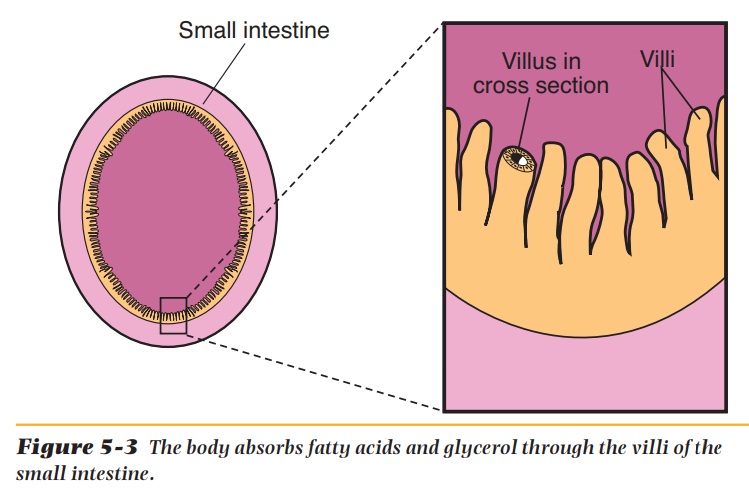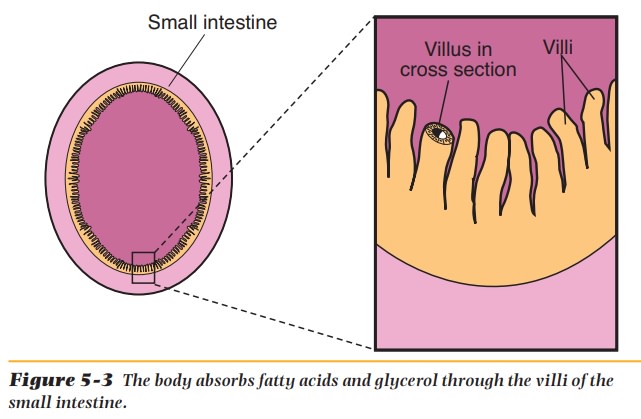Chapter: Nutrition and Diet Therapy: Lipids or Fats
Digestion and Absorption of Lipids or Fats

DIGESTION AND ABSORPTION
Although 95% of
ingested fats are digested, it is a complex process. The chemi-cal digestion of
fats occurs mainly in the small intestine. Fats are not digested in the mouth.
They are digested only slightly in the stomach, where gastric lipase acts on
emulsified fats such as those found in cream and egg yolk. Fats must be mixed well
with the gastric juices before entering the small intestine.
In the small
intestine, bile emulsifies the fats, and the enzyme pancreatic lipase reduces
them to fatty acids and glycerol, which the body subsequently absorbs through
villi (Figure 5-3).

Lipoproteins
Fats are insoluble in
water, which is the main component of blood. There-fore, special carriers must
be provided for the fats to be absorbed and transported by the blood to body
cells. In the initial stages of absorption, bile joins with the products of fat
digestion to carry fat. Later, protein com-bines with the final products of fat
digestion to form special carriers called lipoproteins.
The lipoproteins subsequently carry the fats to the body cellsby
way of the blood.
Lipoproteins are
classified as chylomicrons,
very-low-density lipo-proteins (VLDLs), low-density lipoproteins (LDLs), and high-density lipoproteins (HDLs), according to their
mobility and density. Chylomicronsare the first lipoprotein identified after
eating. They are the largest lipoproteins and the lightest in weight. They are
composed of 80% to 90% triglycerides. Lipoprotein lipase acts to break down the
triglycerides into free fatty acids and glycerol. Without this enzyme, fat
could not get into the cells.
Very-low-density
lipoproteins are made primarily by the liver cells and are composed of 55% to
65% triglycerides. They carry triglycerides and other lipids to all cells. As
the VLDLs lose triglycerides, they pick up cholesterol from other lipoproteins
in the blood, and they then become LDLs. Low-density lipoproteins are
approximately 45% cholesterol with few triglycerides. They carry most of the
blood cholesterol from the liver to the cells. Elevated blood levels greater
than 130 mg/dl of LDL are thought to be contributing factors in
atherosclerosis. Low-density lipoprotein is sometimes termed bad cholesterol.
High-density
lipoproteins carry cholesterol from the cells to the liver for eventual
excretion. The level at which low HDL becomes a major risk factor for heart
disease has been set at 40 mg/dl. Research indicates that an HDL level of 60
mg/dl or more is considered protective against heart disease. High-density
lipoproteins are sometimes called good
cholesterol. Exercising, maintaining a desirable weight, and giving up
smoking are all ways to in-crease one’s HDL.
Related Topics